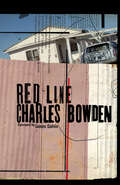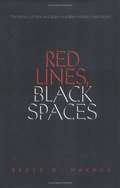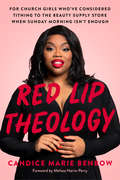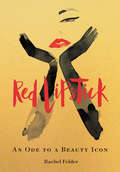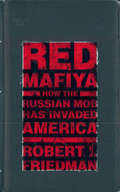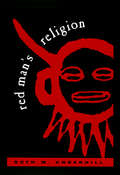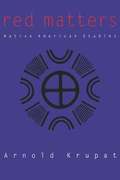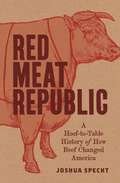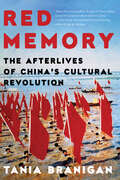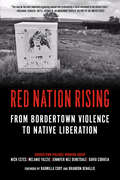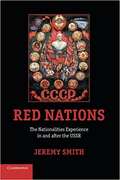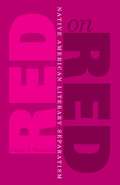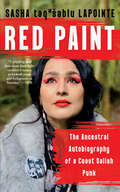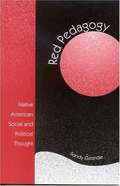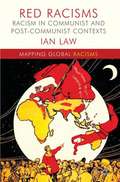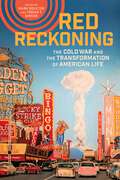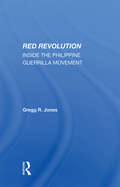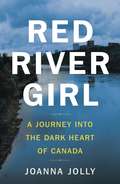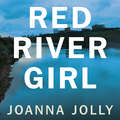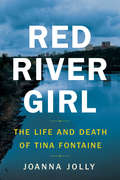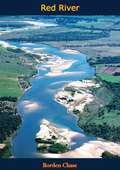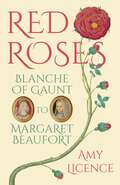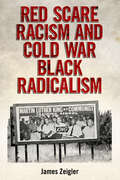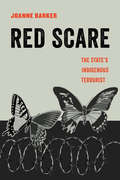- Table View
- List View
Red Lights: The Lives of Sex Workers in Postsocialist China
by Tiantian ZhengIn China today, sex work cannot be untangled from the phenomenon of rural-urban migration, the entertainment industry, and state power. In Red Lights, Tiantian Zheng highlights the urban karaoke bar as the locus at which these three factors intersect and provides a rich account of the lives of karaoke hostesses—a career whose name disguises the sex work and minimizes the surprising influence these women often have as power brokers. Zheng embarked on two years of intensely embedded ethnographic fieldwork in her birthplace, Dalian, a large northeastern Chinese seaport of over six million people. During this time, Zheng lived and worked with a group of hostesses in a karaoke bar, facing many of the same dangers that they did and forming strong, intimate bonds with them. The result is an especially engaging, moving story of young, rural women struggling to find meaning, develop a modern and autonomous identity, and, ultimately, survive within an oppressively patriarchal state system. Moving from her case studies to broader theories of sex, gender, and power, Zheng connects a growth in capitalist entrepreneurialism to the emergence of an urban sex industry, brilliantly illuminating the ways in which hostesses, their clients, and the state are mutually created in postsocialist China.
Red Line
by Charles BowdenThe author is joined by a retired narcotics cop as they investigate the assassination of a drug dealer and hit man outside Tucson, Arizona.One of Charles Bowden&’s earliest books, Red Line powerfully conveys a desert civilization careening over the edge―and decaying at its center. Bowden&’s quest for the literal and figurative truth behind the assassination of a murderous border-town drug dealer becomes a meditation on the glories of the desert landscape, the squalors of the society that threatens it, and the contradictions inherent in trying to save it.&“At its best, Red Line can read like an original synthesis of Peter Matthiessen and William Burroughs . . . A brave and interesting book.&” —David Rieff, Los Angeles Times Book Review&“Charles Bowden&’s Red Line is a look at America through the window of the southwest. His vision is as nasty, peculiar, brutal, as it is intriguing and, perhaps, accurate. Bowden offers consciousness rather than consolation, but in order to do anything about our nightmares we must take a cold look and Red Line casts the coldest eye in recent memory.&” —Jim Harrison&“The Southwest as portrayed in this Kerouac-esque odyssey betokening the death of the American frontier spirit is a landscape of broken dreams, violence, uprooted lives and fallen idols. . . . Miles distant from tourist-poster images of the Sunbelt, this vista of narrow greed, diminished expectations and despoilation of nature sizzles with the harsh, unrelenting glare of a hyperrealist painting.&” —Publishers Weekly
Red Lines, Black Spaces: The Politics of Race and Space in a Black Middle-class Suburb
by Bruce D. HaynesRed Lines, Black Spaces is a case study of Nepperhan-Runyon Heights, one of the first middle-class black suburbs in the New York metropolitan region. Runyon Heights is nestled in the northeast section of Yonkers, New York, on the banks of the Hudson River, in the southwest corner of Westchester County, just north of New York City.
Red Lip Theology: For Church Girls Who've Considered Tithing to the Beauty Supply Store When Sunday Morning Isn't Enough
by Candice Marie BenbowA moving essay collection promoting freedom, self-love, and divine wholeness for Black women and opening new levels of understanding and ideological transformation for non-Black women and allies&“Candice Marie Benbow is a once-in-a-generation theologian, the kind who, having ground dogma into dust with the fine point of a stiletto, leads us into the wide-open spaces of faith.&”—Brittney Cooper, author of Eloquent Rage and co-editor of The Crunk Feminist Collection Blurring the boundaries of righteous and irreverent, Red Lip Theology invites us to discover freedom in a progressive Christian faith that incorporates activism, feminism, and radical authenticity. Essayist and theologian Candice Marie Benbow&’s essays explore universal themes like heartache, loss, forgiveness, and sexuality, and she unflinchingly empowers women who struggle with feeling loved and nurtured by church culture. Benbow writes powerfully about experiences at the heart of her Black womanhood. In honoring her single mother&’s love and triumphs—and mourning her unexpected passing—she finds herself forced to shed restrictions she&’d been taught to place on her faith practice. And by embracing alternative spirituality and womanist theology, and confronting staid attitudes on body positivity and LGBTQ+ rights, Benbow challenges religious institutions, faith leaders, and communities to reimagine how faith can be a tool of liberation and transformation for women and girls.
Red Lipstick: An Ode to a Beauty Icon
by Rachel FelderA unique, full-color compendium that celebrates and explores the enduring power and allure of the world’s most iconic lip shade, jam-packed with entertaining stories, anecdotes, little-known facts, quotes, and more than 100 gorgeous images culled from fine art, photography, and beauty and fashion editorial and advertising.“Pour yourself a drink, put on some lipstick, and pull yourself together.” — Elizabeth TaylorLipstick is the one makeup item most women can’t live without—and the most iconic shade is red. Exuding power, sensuality, allure, and mystery, red lips have been a constant of fashion for more than 5,000 years, beginning with Mesopotamian women around 3500 B.C. Throughout the ages, red lipstick has been a signature look worn by royalty, celebrities, and real women across cultures and geography. In fact, nearly all women own a tube of red lipstick, whether it’s the favorite shade they’ve been wearing devotedly for years, or as beauty boost they use for special occasions.Filled with a show-stopping selection of images and distinctively packaged—the size of a clutch, with a jacket printed with a matte, velvet, red finish—Red Lipstick is the only cultural history of this makeup essential available. Granted unprecedented access to experts and the archives of revered brands like Chanel and Elizabeth Arden, beauty writer Rachel Felder explores the origins and allure of red lipstick and illuminates its association with aristocracy, sex appeal, illicit sexuality, rebellion, power, glamour, fame, and beauty. She also spotlights the fascinating array of women who have worn it through the ages, including monarchs, suffragettes, flappers, working women in World War II, first ladies, political leaders, geishas, Hollywood sirens, rock and rollers, fashionistas, and more. Inside this enthralling book, you’ll discover why red lipstick makes women more attractive to others (and the science behind it); tips on choosing the most perfect shade of crimson; and a wealth of anecdotes, quotations, select literary excerpts, and trivia, such as the shade Carolyn Bessette Kennedy wore on her wedding day. Red Lipstick is packed with a museum’s worth of fine art, including both Man Ray’s photograph “Red Badge of Courage” and infamous painting “Les Amoreaux;” lush, rarely seen vintage magazine advertisements from stalwart brands like Guerlain and Dior; illustrations by renowned fashion illustrators such as René Gruau, Daisy Villeneuve, and Bil Donovan; artists Dante Gabriel Rossetti, Edgar Degas, Ernst Ludwig Kirchner, Wayne Thiebaud, and Walt Kuhn; and images of famous red lipstick wearers including Cleopatra, Queen Elizabeth II, Coco Chanel, Grace Kelly, Marilyn Monroe, Audrey Hepburn, Madonna, Diana Vreeland, Rihanna, Paloma Picasso, and many others. With its captivating, chic design, beautiful selection of visuals, and engaging, entertaining text, Red Lipstick is a classic, like the perfect red lip shade itself.
Red Mafiya: How the Russian Mob has Invaded America
by Robert I. FriedmanIn the past decade, from Brighton Beach to Moscow, Toronto to Hong Kong, the Russian mob has become the world's fastest-growing criminal superpower. Trafficking in prostitutes, heroin, and missiles, the mafiya poses an enormous threat to global stability and safety. Today, the mafiya controls over 80 percent of Russia's banks and has siphoned off billions of dollars in Western loans and aid, almost certainly derailing the chance for a stable democracy there. But that is just the beginning, for the mafiya is now in every corner of the United States and has infiltrated some of the banks and brokerage firms that handle your money. And American law enforcement is just waking up to this staggering problem. -- No journalist in the world knows more about the mafiya than Friedman, who has covered the Russian mob for Details, Vanity Fair, and New York. -- At great peril to himself, Friedman interviewed many of the top mobsters, who were stunningly candid about their activities. -- In their depravity, ruthlessness, and brutality, Russian gangsters make the traditional Mafia look like choirboys. Red Mafiya will appeal to anyone interested in the Mob.
Red Man's Religion: Beliefs and Practices of the Indians North of Mexico
by Ruth MurrayAmong the topics considered in this classic study are world origins and supernatural powers, attitudes toward the dead, the medicine man and shaman, hunting and gathering rituals, war and planting ceremonies, and newer religions, such as the Ghost Dance and the Peyote Religion. "The distinctive contribution of [Red Man's Religion] is the treatment of topics, the insight and the perspective of the author, and her ability to transmit these to the reader. . . . Trais and aspects of religion are not treated as abstract entitites, to be enumerated and summated, assigned a geographic distribution, and then abandoned. No page is a dry recital; each is an illumination. Insight and wisdom are framed in poetic prose. An offering of information in such a medium merits gratitude."—American Anthropologist
Red Matters
by Arnold KrupatArnold Krupat, one of the most original and respected critics working in Native American studies today, offers a clear and compelling set of reasons why red--Native American culture, history, and literature--should matter to Americans more than it has to date. Although there exists a growing body of criticism demonstrating the importance of Native American literature in its own right and in relation to other ethnic and minority literatures, Native materials still have not been accorded the full attention they require. Krupat argues that it is simply not possible to understand the ethical and intellectual heritage of the West without engaging America's treatment of its indigenous peoples and their extraordinary and resilient responses. Criticism of Native literature in its current development, Krupat suggests, operates from one of three critical perspectives against colonialism that he calls nationalism, indigenism, and cosmopolitanism. Nationalist critics are foremost concerned with tribal sovereignty, indigenist critics focus on non-Western modes of knowledge, and cosmopolitan critics wish to look elsewhere for comparative possibilities. Krupat persuasively contends that all three critical perspectives can work in a complementary rather than an oppositional fashion. A work marked by theoretical sophistication, wide learning, and social passion, Red Matters is a major contribution to the imperative effort of understanding the indigenous presence on the American continents.
Red Meat Republic: A Hoof-to-Table History of How Beef Changed America (Histories Of Economic Life Ser. #3)
by Joshua SpechtHow beef conquered America and gave rise to the modern industrial food complexBy the late nineteenth century, Americans rich and poor had come to expect high-quality fresh beef with almost every meal. Beef production in the United States had gone from small-scale, localized operations to a highly centralized industry spanning the country, with cattle bred on ranches in the rural West, slaughtered in Chicago, and consumed in the nation’s rapidly growing cities. Red Meat Republic tells the remarkable story of the violent conflict over who would reap the benefits of this new industry and who would bear its heavy costs.Joshua Specht puts people at the heart of his story—the big cattle ranchers who helped to drive the nation’s westward expansion, the meatpackers who created a radically new kind of industrialized slaughterhouse, and the stockyard workers who were subjected to the shocking and unsanitary conditions described by Upton Sinclair in his novel The Jungle. Specht brings to life a turbulent era marked by Indian wars, Chicago labor unrest, and food riots in the streets of New York. He shows how the enduring success of the cattle-beef complex—centralized, low cost, and meatpacker dominated—was a consequence of the meatpackers’ ability to make their interests overlap with those of a hungry public, while the interests of struggling ranchers, desperate workers, and bankrupt butchers took a backseat. America—and the American table—would never be the same again.A compelling and unfailingly enjoyable read, Red Meat Republic reveals the complex history of exploitation and innovation behind the food we consume today.
Red Memory: The Afterlives of China's Cultural Revolution
by Tania BraniganWinner of the Cundill History Prize Shortlisted for the Baillie Gifford Prize for Non-Fiction Shortlisted for the Kirkus Prize in Nonfiction Shortlisted for the British Academy Book Prize for Global Cultural Understanding One of Time's 100 Must-Read Books of 2023 “Masterful and crystalline. It feels as if Joan Didion turned her powers of observation on China.” —Evan Osnos, National Book Award–winning author of Age of Ambition An indelible exploration of the invisible scar that runs through the heart of Chinese society and the souls of its citizens. “It is impossible to understand China today without understanding the Cultural Revolution,” Tania Branigan writes. During this decade of Maoist fanaticism between 1966 and 1976, children turned on parents, students condemned teachers, and as many as two million people died for their supposed political sins, while tens of millions were hounded, ostracized, and imprisoned. Yet in China this brutal and turbulent period exists, for the most part, as an absence; official suppression and personal trauma have conspired in national amnesia. Red Memory uncovers forty years of silence through the stories of individuals who lived through the madness. Deftly exploring how this era defined a generation and continues to impact China today, Branigan asks: What happens to a society when you can no longer trust those closest to you? What happens to the present when the past is buried, exploited, or redrawn? And how do you live with yourself when the worst is over?
Red Nation Rising: From Bordertown Violence to Native Liberation
by David Correia Nick Estes Jennifer Nez Denetdale Melanie K. YazzieRed Nation Rising is the first book ever to investigate and explain the violent dynamics of bordertowns. Bordertowns are white-dominated towns and cities that operate according to the same political and spatial logics as all other American towns and cities. The difference is that these settlements get their name from their location at the borders of current-day reservation boundaries, which separates the territory of sovereign Native nations from lands claimed by the United States. Bordertowns came into existence when the first US military forts and trading posts were strategically placed along expanding imperial frontiers to extinguish indigenous resistance and incorporate captured indigenous territories into the burgeoning nation-state. To this day, the US settler state continues to wage violence on Native life and land in these spaces out of desperation to eliminate the threat of Native presence and complete its vision of national consolidation "from sea to shining sea." This explains why some of the most important Native-led rebellions in US history originated in bordertowns and why they are zones of ongoing confrontation between Native nations and their colonial occupier, the
Red Nations
by Jeremy SmithRed Nations offers an illuminating and informative overview of how the non-Russian republics of the Soviet Union experienced communist rule. It surveys the series of historical events that contributed to the break-up of the Soviet Union and evaluates their continuing resonance across post-soviet states today. Drawing from the latest research, Professor Smith offers comprehensive coverage of the revolutionary years, the early Soviet policies of developing nations, Stalin's purges and deportations of small nationalities, and the rise of independence movements. Through a single, unified narrative, this book illustrates how, in the post-Stalin period, many of the features of the modern nation state emerged. Both scholars and students will find this an indispensable contribution to the history of the dissolution of the USSR, the reconstruction of post-Soviet society, and its impact on non-Russian citizens from the years of the Russian Revolution through to the present day.
Red On Red: Native American Literary Separatism
by Craig S. WomackAn entertaining and enlightening proposal for a new way to read Native American literature.How can a square peg fit into a round hole? It can&’t. How can a door be unlocked with a pencil? It can&’t. How can Native literature be read applying conventional postmodern literary criticism? It can&’t.That is Craig Womack&’s argument in Red on Red. Indian communities have their own intellectual and cultural traditions that are well equipped to analyze Native literary production. These traditions should be the eyes through which the texts are viewed. To analyze a Native text with the methods currently dominant in the academy, according to the author, is like studying the stars with a magnifying glass.In an unconventional and piercingly humorous appeal, Womack creates a dialogue between essays on Native literature and fictional letters from Creek characters who comment on the essays. Through this conceit, Womack demonstrates an alternative approach to American Indian literature, with the letters serving as a &“Creek chorus&” that offers answers to the questions raised in his more traditional essays. Topics range from a comparison of contemporary oral versions of Creek stories and the translations of those stories dating back to the early twentieth century, to a queer reading of Cherokee author Lynn Riggs&’s play The Cherokee Night.Womack argues that the meaning of works by Native peoples inevitably changes through evaluation by the dominant culture. Red on Red is a call for self-determination on the part of Native writers and a demonstration of an important new approach to studying Native works-one that engages not only the literature, but also the community from which the work grew.
Red Paint: The Ancestral Autobiography of a Coast Salish Punk
by Sasha LaPointeAn Indigenous artist blends the aesthetics of punk rock with the traditional spiritual practices of the women in her lineage in this bold, contemporary journey to reclaim her heritage and unleash her power and voice while searching for a permanent homeSasha taqʷšəblu LaPointe has always longed for a sense of home. When she was a child, her family moved around frequently, often staying in barely habitable church attics and trailers, dangerous places for young Sasha. With little more to guide her than a passion for the thriving punk scene of the Pacific Northwest and a desire to live up to the responsibility of being the namesake of her beloved great-grandmother—a linguist who helped preserve her Indigenous language of Lushootseed—Sasha throws herself headlong into the world, determined to build a better future for herself and her people. Set against a backdrop of the breathtaking beauty of Coast Salish ancestral land and imbued with the universal spirit of punk, Red Paint is ultimately a story of the ways we learn to find our true selves while fighting for our right to claim a place of our own. Examining what it means to be vulnerable in love and in art, Sasha offers up an unblinking reckoning with personal traumas amplified by the collective historical traumas of colonialism and genocide that continue to haunt native peoples. Red Paint is an intersectional autobiography of lineage, resilience, and, above all, the ability to heal.
Red Pedagogy: Native American Social and Political Thought
by Sandy GrandeThis ground-breaking text explores the intersection between dominant modes of critical educational theory and the socio-political landscape of American Indian education. Grande asserts that, with few exceptions, the matters of Indigenous people and Indian education have been either largely ignored or indiscriminately absorbed within critical theories of education.
Red Racisms
by Ian LawRacism in the Soviet Union and in other Communist contexts has frequently been denied and ignored. This is the first book to provide an analysis of racism and racialization in Communist and post-Communist contexts. It opens up debates about both the relationship between racism and communism and the racial logics at work, how they have come into being and how they have changed in the contemporary world. This is a major advancement in our understanding of processes of global racialization and this book includes new analysis and evidence on the battle to challenge the racist underground in the Russian Federation, the postwar experiences of the Roma in Hungary, Romania, Slovakia and the Czech Republic, new Afro-Cuban movements and on Tibetan struggles against Chinese domination. "
Red Reckoning: The Cold War and the Transformation of American Life
by Dr Linda Weiss Dr Ann V. Collins Dr Kurt W. Jefferson Dr Eric Kasper Dr Elaine Tyler May Dr Peter J. Verovšek Matt Sprengeler Dr Mary Beth Chopas Dr Tony Shaw Dr Francesco Buscemi Dr Kurt Edward Kemper Dr Angela F. Keaton Dr Charity Rakestraw Dr Randi Barnes Cox Dr Simon Stow Dr Eunice RojasThough it ended more than thirty years ago, the Cold War still casts a long shadow over American society. Red Reckoning examines how the great ideological conflict of the twentieth century transformed the nation and forced Americans to reconsider almost every aspect of their society, culture, and identity.Using an interdisciplinary approach, the volume’s contributors examine a broad array of topics, including the Cold War’s impact on national security, race relations, gun culture and masculinity, law, college football, advertising, music, film, free speech, religion, and even board games. Above all, Red Reckoning brings a vitally important era back to life for those who lived through it and for students and scholars wishing to understand it.
Red Revolution: Inside The Philippine Guerrilla Movement
by Gregg R. JonesThis book is about the Communist Party of the Philippines (CPP) and its guerrilla army. Its objective is to offer the reader a close-up look and analysis of the revolution and serves as a case study of the inner workings of one of the most successful communist revolutionary movements.
Red River Girl: A Journey into the Dark Heart of Canada - The International Bestseller
by Joanna JollyTHE GRIPPING TRUE STORY OF A MURDER WHICH HAUNTED CANADA AND BECAME A RALLYING CRY FOR JUSTICE'If you were hooked on the Serial podcast, then you need to order this now' RedLonglisted for the Crime Writers' Association ALCS Gold Dagger for Non-FictionTina FontaineA fifteen-year-old runaway living on the streets of Winnipeg. When her body was found weighted down in the Red River, she became yet another example of the endemic violence against Indigenous women. But her death sparked a nationwide protest. Sergeant John O'DonovanThe police detective who forced the media to look at Tina differently. Vowing to deliver justice, he plotted an extraordinary undercover sting that stretched the moral boundaries of the law and obsessed him for years.Joanna JollyAn award-winning journalist whose investigation into Tina's death took her to the prison cell of the murder suspect, theFirst Nation reserve where Tina was raised and into the heart of a liberal nation confronting racism and injustice.'Written with the urgency of a thriller, this book uses the tragic death of one girl to expose scandalous levels of violence against Canada's Indigenous female population. A shocking story' Joan Smith, author of Misogynies'Jolly's gripping, moving and timely book is a true crime classic. Vital, urgent and humane' Melanie McGrath, author of The Long Exile
Red River Girl: A Journey into the Dark Heart of Canada - The International Bestseller
by Joanna JollyLonglisted for the Crime Writers' Association ALCS Gold Dagger for Non-FictionA gripping account of the unsolved death of an Indigenous teenager, the detective determined to find her killer and a country's hidden secretsOn 17 August 2014, the body of fifteen-year old Indigenous runaway Tina Fontaine was found weighted down in the Red River in the Canadian city of Winnipeg. The loss of Tina was a tragedy for her family and for the Indigenous community. But it also exposed a national scandal: Indigenous women are vastly more likely than other Canadians to be assaulted and killed. Over the past few decades, hundreds had been murdered - or simply gone missing. Many of these cases have never been solved.Tina's Fontaine's death caused an outcry across Canada. The police investigation and trial that followed sparked a widespread debate on the treatment of Indigenous women, while the movement protesting those missing and murdered became an international news story. In an astonishing feat of investigation, award-winning BBC reporter and documentary maker Joanna Jolly has reconstructed Tina's life, from her childhood on the Sagkeeng First Nation Reserve to her difficult teenage years. Red River Girl is the compelling story of the elaborate police investigation into Fontaine's death and the detective obsessed with bringing her killer to justice - and an exploration of the dark side of a country known for its tolerance and liberal values. It reveals how Indigenous women, sex workers, community leaders and activists are fighting back to protect themselves and change perceptions. Most importantly, Red River Girl is an unforgettable description of the search for justice.
Red River Girl: The Life and Death of Tina Fontaine
by Joanna JollyA gripping account of the unsolved death of an Indigenous teenager, and the detective determined to find her killer, set against the backdrop of a troubled city.On August 17, 2014, the body of fifteen-year old runaway Tina Fontaine was found in Winnipeg's Red River. It was wrapped in material and weighted down with rocks. Red River Girl is a gripping account of that murder investigation and the unusual police detective who pursued the killer with every legal means at his disposal. The book, like the movie Spotlight, will chronicle the behind-the-scenes stages of a lengthy and meticulously planned investigation. It reveals characters and social tensions that bring vivid life to a story that made national headlines.Award-winning BBC reporter and documentary maker Joanna Jolly delves into the troubled life of Tina Fontaine, the half-Ojibway, half-Cree murder victim, starting with her childhood on the Sagkeeng First Nation Reserve. Tina's journey to the capital city is a harrowing one, culminating in drug abuse, sexual exploitation, and death. Aware of the reality of missing and murdered Indigenous women and girls, Jolly has chronicled Tina Fontaine's life as a reminder that she was more than a statistic. Raised by her father, and then by her great-aunt, Tina was a good student. But the violent death of her father hit Tina hard. She ran away, was found and put into the care of Child and Family Services, which she also sought to escape from. That choice left her in danger.Red River Girl focuses not on the grisly event itself, but on the efforts to seek justice. In December 2015, the police charged Raymond Cormier, a drifter, with second-degree murder. Jolly's book will cover the trial, which resulted in an acquittal. The verdict caused dismay across the country. The book is not only a true crime story, but a portrait of a community where Indigenous women are disproportionately more likely to be hurt or killed. Jolly asks questions about how Indigenous women, sex workers, community leaders, and activists are fighting back to protect themselves and change perceptions. Most importantly, the book will chronicle whether Tina's family will find justice.
Red River: Blazing Guns On The Chisholm Trail
by Borden ChaseThe book that launched the classic Howard Hawks western starring John Wayne and Montgomery Clift.—HALF A CATTLE EMPIRE—for a son...Now Dunson turned that blunt gaze on Tess. He let the gray eyes run slowly over her shoulders and breasts and hips...“What would you say, Tess Millay, if I offered you half of an empire in exchange for a son?”“...Your son?”“Yes.”The great State of Texas is dying...herds of cattle run wild...an uncharted trail leads to nowhere—but Colonel Dunson would fight on to save his empire, just so long as he had this woman by his side.Here is a Western that has been cut out of the lonely stretches of Texas, patterned from the lives of great giants of the land. A smashing story that pounds like the drumming hoofs of 10,000 cattle—a yarn that will hold you through the 100-day drive along the historic Chisholm Trail.
Red Roses: Blanche of Gaunt to Margaret Beaufort
by Amy LicenceThe Wars of the Roses were not just fought by men on the battlefield. Behind the scenes, there were daughters, wives, mistresses, mothers and queens whose lives and influences helped shape the most dramatic of English conflicts.This book traces the story of women on the Lancastrian side, from the children borne by Blanche, wife of John of Gaunt, through the turbulent fifteenth century to the advent of Margaret Beaufort’s son in 1485 and the establishment of the Tudor dynasty. From the secret liaisons of Katherine Swynford and Catherine of Valois to the love lives of Mary de Bohun and Jacquetta of Luxembourg, to the queenship of Joan of Navarre and Margaret of Anjou, this book explores their experiences as women. What bound them to their cause? What real influence did they wield?Faced with the dangers of treason and capture, defamation and childbirth, read how these extraordinary women survived in extraordinary times.
Red Scare Racism and Cold War Black Radicalism (Race, Rhetoric, and Media Series)
by James ZeiglerDuring the early years of the Cold War, racial segregation in the American South became an embarrassing liability to the international reputation of the United States. For America to present itself as a model of democracy in contrast to the Soviet Union's totalitarianism, Jim Crow needed to end. While the discourse of anticommunism added the leverage of national security to the moral claims of the civil rights movement, the proliferation of Red Scare rhetoric also imposed limits on the socioeconomic changes necessary for real equality. Describing the ways anticommunism impaired the struggle for civil rights, James Zeigler reconstructs how Red Scare rhetoric during the Cold War assisted the black freedom struggle's demands for equal rights but labeled “un-American” calls for reparations. To track the power of this volatile discourse, Zeigler investigates how radical black artists and intellectuals managed to answer anticommunism with critiques of Cold War culture. Stubbornly addressed to an American public schooled in Red Scare hyperbole, black radicalism insisted that antiracist politics require a leftist critique of capitalism. Zeigler examines publicity campaigns against Dr. Martin Luther King Jr.'s alleged Communist Party loyalties and the import of the Cold War in his oratory. He documents a Central Intelligence Agency-sponsored anthology of ex-Communist testimonials. He takes on the protest essays of Richard Wright and C. L. R. James, as well as Frank Marshall Davis's leftist journalism. The uncanny return of Red Scare invective in reaction to President Obama's election further substantiates anticommunism's lasting rhetorical power as Zeigler discusses conspiracy theories that claim Davis groomed President Obama to become a secret Communist. Long after playing a role in the demise of Jim Crow, the Cold War Red Scare still contributes to the persistence of racism in America.
Red Scare: The State's Indigenous Terrorist (American Studies Now: Critical Histories of the Present #14)
by Joanne BarkerHow the rhetoric of terrorism has been used against high-profile movements to justify the oppression and suppression of Indigenous activists. New Indigenous movements are gaining traction in North America: the Missing and Murdered Women and Idle No More movements in Canada, and the Native Lives Matter and NoDAPL movements in the United States. These do not represent new demands for social justice and treaty rights, which Indigenous groups have sought for centuries. But owing to the extraordinary visibility of contemporary activism, Indigenous people have been newly cast as terrorists—a designation that justifies severe measures of policing, exploitation, and violence. Red Scare investigates the intersectional scope of these four movements and the broader context of the treatment of Indigenous social justice movements as threats to neoliberal and imperialist social orders. In Red Scare, Joanne Barker shows how US and Canadian leaders leverage the fear-driven discourses of terrorism to allow for extreme responses to Indigenous activists, framing them as threats to social stability and national security. The alignment of Indigenous movements with broader struggles against sexual, police, and environmental violence puts them at the forefront of new intersectional solidarities in prominent ways. The activist-as-terrorist framing is cropping up everywhere, but the historical and political complexities of Indigenous movements and state responses are unique. Indigenous criticisms of state policy, resource extraction and contamination, intense surveillance, and neoliberal values are met with outsized and shocking measures of militarized policing, environmental harm, and sexual violence. Red Scare provides students and readers with a concise and thorough survey of these movements and their links to broader organizing; the common threads of historical violence against Indigenous people; and the relevant alternatives we can find in Indigenous forms of governance and relationality.

